Earl Marshal
Earl Marshal (alternatively Marschal or Marischal) is a hereditary royal officeholder and chivalric title under the sovereign of the United Kingdom used in England (then, following the Act of Union 1800, in the United Kingdom). He is the eighth of the Great Officers of State in the United Kingdom, ranking beneath the Lord High Constable and above the Lord High Admiral. A Duke of Norfolk has held the office since 1672.
| Earl Marshal | |
|---|---|
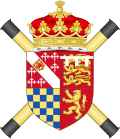 Arms of the Dukes of Norfolk as Earl Marshal. | |
| Style | His Grace |
| Inaugural holder | Henry Howard, 6th Duke of Norfolk (1672 creation) |
| Formation | 1672 (current office granted by Letters Patent) |
The marshal was originally responsible, along with the constable, for the monarch's horses and stables including connected military operations. As a result of the decline of chivalry and sociocultural change, the position of Earl Marshal has evolved and among his responsibilities today is the organisation of major ceremonial state occasions like the monarch's coronation in Westminster Abbey and state funerals.[1] He is also the leading officer of arms and oversees the College of Arms.
The current Earl Marshal is Edward Fitzalan-Howard, 18th Duke of Norfolk, who inherited the position in 2002. There was formerly an Earl Marshal of Ireland and Earl Marischal of Scotland.
England
The office of royal marshal existed in much of Europe, involving managing horses and protecting the monarch. In England, the office became hereditary under John FitzGilbert the Marshal (served c.1130–1165) after The Anarchy, and rose in prominence under his second son, William Marshal, later Earl of Pembroke. He served under several kings, acted as regent, and organised funerals and the regency during Henry III's childhood. After passing through his daughter's husband to the Earls of Norfolk, the post evolved into "Earl Marshal" and the title remained unchanged, even after the earldom of Norfolk became a dukedom.
In the Middle Ages, the Earl Marshal and the Lord High Constable were the officers of the king's horses and stables. When chivalry declined in importance, the constable's post declined and the Earl Marshal became the head of the College of Arms, the body concerned with all matters of genealogy and heraldry. In conjunction with the Lord High Constable, he had held a court, known as the Court of Chivalry, for the administration of justice in accordance with the law of arms, which was concerned with many subjects relating to military matters, such as ransom, booty and soldiers' wages, and including the misuse of armorial bearings.
In 1672, the office of Marshal of England and the title of Earl Marshal of England were made hereditary in the Howard family.[2][3][4] In a declaration made on 16 June 1673 by Arthur Annesley, 1st Earl of Anglesey, the Lord Privy Seal, in reference to a dispute over the exercise of authority over the Officers of Arms the powers of the Earl Marshal were stated as being "to have power to order, judge, and determine all matters touching arms, ensigns of nobility, honour, and chivalry; to make laws, ordinances and statutes for the good government of the Officers of Arms; to nominate Officers to fill vacancies in the College of Arms; [and] to punish and correct Officers of Arms for misbehaviour in the execution of their places".[5] Additionally it was declared that no patents of arms or any ensigns of nobility should be granted, and no augmentation, alteration, or addition should be made to arms, without the consent of the Earl Marshal.
The Earl Marshal is considered the eighth of the Great Officers of State, with the Lord High Constable above him and only the Lord High Admiral beneath him. Nowadays, the Earl Marshal's role has mainly to do with the organisation of major state ceremonies such as coronations and state funerals. Annually, the Earl Marshal helps organise the State Opening of Parliament. The Earl Marshal also remains to have charge over the College of Arms and no coat of arms may be granted without his warrant. As a symbol of his office, he carries a baton of gold with black finish at either end.
In the general order of precedence, the Earl Marshal is currently the highest hereditary position in the United Kingdom outside the Royal Family. Although other state and ecclesiastical officers rank above in precedence, they are not hereditary. The exception is the office of Lord Great Chamberlain, which is notionally higher than Earl Marshal and also hereditary, but as it is currently held by a marquess (Marquess of Cholmondeley), is consequently lower in the general order of precedence. The holding of the Earl Marshalship secures the Duke of Norfolk's traditional position as the "first peer" of the land, above all other dukes.
The House of Lords Act 1999 removed the automatic right of hereditary peers to sit in the House of Lords, but the Act provided that the persons holding the office of Earl Marshal and, if a peer, the Lord Great Chamberlain continue for the time being to have seats so as to carry out their ceremonial functions in the House of Lords.
Ireland
Among the men who have held the title of Earl Marshal of Ireland are: -
- William Marshal, 1st Earl of Pembroke (died 1219)
- John Marshal (died 1235) (illegitimate son of John Marshal, brother of the above William Marshal, who died in 1194)
- William Marshal 'who joined the Barons against King Henry III and d. 1264' (grandson of the last-mentioned John Marshal)[6]
- John Marshal, son of the last-mentioned and father of the next-mentioned.[6]
- William Marshal, 1st Baron Marshal (died 1314)[6]
- John Marshal, 2nd Baron Marshal (died 1316/17)[6]
- Robert de Morley, 2nd Baron Morley (died 1360) (husband of Hawisia, sister of the last-mentioned John Marshal)[7]
- William de Morley, 3rd Baron Morley (died 1379)[7]
- Thomas de Morley, 4th Baron Morley (died 1416)[7]
- Thomas de Morley, 5th Baron Morley (died 1435)[7]
(The Barony of Morley was held by his descendants until it fell into abeyance in 1697)
- Sir William Brereton, under Henry VIII.
- Walter Devereux, 1st Earl of Essex (1539–1576).
See
- A view of the legal institutions, honorary hereditary offices ... Walter Lynch, 1830, P 71
- Unpublished statute entered on the Chancery Roll, Dublin, in the year 1460, relative to the independence of Ireland
- Family Tree of the Marshal family, from J.H Round, "The king's serjeants & officers of state, with their coronation services" P368
Scotland
See Earl Marischal.
Lords Marshal of England, 1135–1386
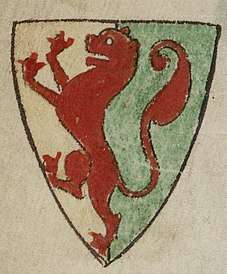
- Gilbert Marshal ?–1129 (?)
- John Marshal 1130–1165 (?)
- John Marshal 1165–1194
- William Marshal, 1st Earl of Pembroke 1194–1219
- William Marshal, 2nd Earl of Pembroke 1219–1231
- Richard Marshal, 3rd Earl of Pembroke 1231–1234
- Gilbert Marshal, 4th Earl of Pembroke 1234–1241
- Walter Marshal, 5th Earl of Pembroke 1242–1245
- Anselm Marshal, 6th Earl of Pembroke 1245
- Roger Bigod, 4th Earl of Norfolk 1245–1269
- Roger Bigod, 5th Earl of Norfolk 1269–1306
- Robert de Clifford 1307–1308
- Nicholas Seagrave 1308–1316
- Thomas of Brotherton, 1st Earl of Norfolk 1316–1338
- William Montagu, 1st Earl of Salisbury 1338-1344
- Margaret, Duchess of Norfolk 1338–1377
- Henry Percy, Lord Percy 1377
- John FitzAlan, 1st Baron Arundel, Lord Maltravers 1377–1383 (died 1379)
- Thomas Mowbray, 1st Earl of Nottingham 1385–1386
Earls Marshal of England, 1386–present
| Portrait | Name (Birth–Death) |
Term of office | Monarch (Reign) | |
|---|---|---|---|---|
 |
Thomas de Mowbray 1st Duke of Norfolk KG (1367/68–1399) |
1386 | 1398 | Richard II.svg.png) (1377–1399) |
 |
Thomas Holland 1st Duke of Surrey KG (1374–1400) |
1398 | 1399 | |
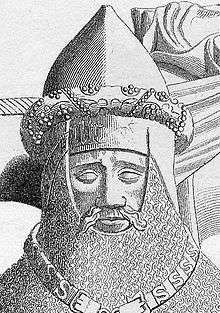 |
Ralph de Neville 1st Earl of Westmorland KG PC (c. 1364–1425) |
1400 | 1412 | Henry IV.svg.png) (1399–1413) |
 |
John de Mowbray 2nd Duke of Norfolk KG (1392–1432) |
1412 | 1432 | |
| Henry V (1413–1422) | ||||
Henry VI.svg.png) (1422–1461) | ||||
 |
John de Mowbray 3rd Duke of Norfolk KG (1415–1461) |
1432 | 1461 | |
 |
John de Mowbray 4th Duke of Norfolk KG (1444–1476) |
1461 | 1476 | Edward IV (1461–1470) |
| Henry VI (1470–1471) | ||||
Edward IV.svg.png) (1471–1483) | ||||
 |
Jointly:
|
1476 | 1483 | |
Edward V.svg.png) (1483–1483) | ||||
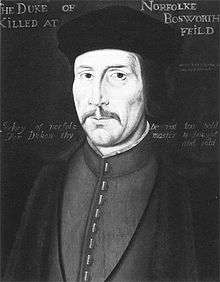 |
John Howard 1st Duke of Norfolk KG (c. 1425–1485) |
1483 | 1485 | Richard III.svg.png) (1483–1485) |
 |
William de Berkeley 1st Marquess of Berkeley PC (1426–1492) |
1486 | 1492 | Henry VII.svg.png) (1485–1509) |
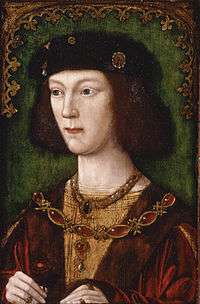 |
Lord Henry Duke of York KG PC (1491–1547) |
1494 | 1509 | |
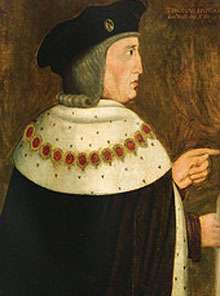 |
Thomas Howard 2nd Duke of Norfolk KG PC (1443–1524) |
1509 | 1524 | Henry VIII.svg.png) (1509–1547) |
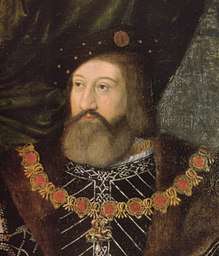 |
Charles Brandon 1st Duke of Suffolk KG (1484–1545) |
1524 | 1533 | |
| Thomas Howard 3rd Duke of Norfolk KG PC (1473–1554) |
1533 | 1547 | ||
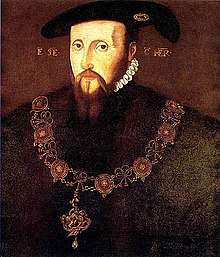 |
Edward Seymour 1st Duke of Somerset KG (c. 1500–1552) |
1547 | 1551 | Edward VI.svg.png) (1547–1553) |
.jpg) |
John Dudley 1st Duke of Northumberland KG PC (1504–1553) |
1551 | 1553 | |
| Thomas Howard 3rd Duke of Norfolk KG PC (1473–1554) |
1553 | 1554 | Mary I.svg.png) (1553–1558) | |
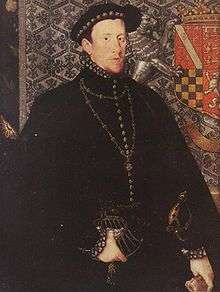 |
Thomas Howard 4th Duke of Norfolk KG (1536–1572) |
1554 | 1572 | |
Elizabeth I.svg.png) (1558–1603) | ||||
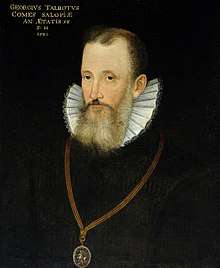 |
George Talbot 6th Earl of Shrewsbury KG (1528–1590) |
1572 | 1590 | |
 |
In commission: |
1590 | 1597 | |
 |
Robert Devereux 2nd Earl of Essex KG PC (1565–1601) |
1597 | 1601 | |
 |
In commission | 1602 | 1603 | |
 |
Edward Somerset 4th Earl of Worcester KG (c. 1550–1628) |
1603 | 1603 | James I.svg.png) (1603–1625) |
 |
In commission:[9] | 1604 | 1616 | |
 |
In commission:[9] | 1616 | 1622 | |
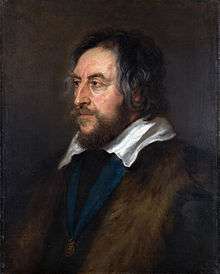 |
Thomas Howard Earl of Arundel and Surrey PC (1586–1646) |
1622 | 1646 | |
Charles I.svg.png) (1625–1649) | ||||
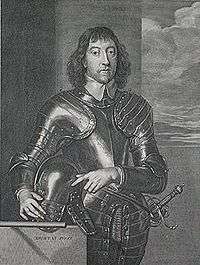 |
Henry Howard Earl of Arundel and Surrey PC (1608–1652) |
1646 | 1652 | |
 |
Vacant | 1652 | 1661 | Interregnum.svg.png) (1649–1660) |
 |
James Howard 3rd Earl of Suffolk (1606/07–1688) |
1661 | 1662 | Charles II.svg.png) (1660–1685) |
 |
In commission:[10] |
1662 | 1672 | |
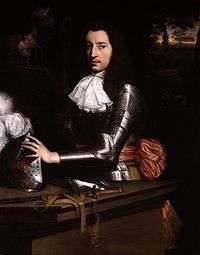 |
Henry Howard 6th Duke of Norfolk (1628–1684) |
1672 | 1684 | |
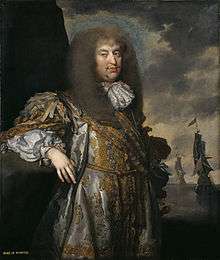 |
Henry Howard 7th Duke of Norfolk KG PC (1655–1701) |
1684 | 1701 | |
James II.svg.png) (1685–1688) | ||||
Mary II.svg.png) (1689–1694) William III .svg.png) (1689–1702) | ||||
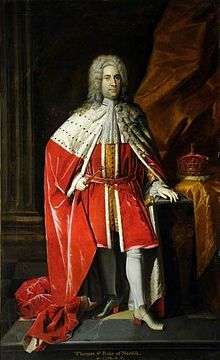 |
Thomas Howard 8th Duke of Norfolk (1683–1732) |
1701 | 1732 | |
Anne.svg.png) .svg.png) (1702–1714) | ||||
George I.svg.png) (1714–1727) | ||||
George II.svg.png) (1727–1760) | ||||
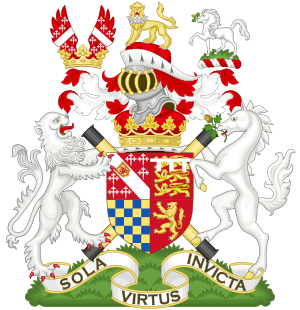 |
Edward Howard 9th Duke of Norfolk (1686–1777) |
1732 | 1777 | |
George III.svg.png) .svg.png) .svg.png) (1760–1820) | ||||
 |
Charles Howard 10th Duke of Norfolk (1720–1786) |
1777 | 1786 | |
%2C_11th_Duke_of_Norfolk_by_James_Lonsdale.jpg) |
Charles Howard 11th Duke of Norfolk (1746–1815) |
1786 | 1815 | |
 |
Bernard Edward Howard 12th Duke of Norfolk KG PC FRS (1765–1842) |
1815 | 1842 | |
George IV.svg.png) (1820–1830) | ||||
William IV.svg.png) (1830–1837) | ||||
Victoria.svg.png) (1837–1901) | ||||
 |
Henry Charles Howard 13th Duke of Norfolk KG PC (1791–1856) |
1842 | 1856 | |
 |
Henry Granville Fitzalan-Howard 14th Duke of Norfolk (1815–1860) |
1856 | 1860 | |
.jpg) |
Henry Fitzalan-Howard 15th Duke of Norfolk KG GCVO VD PC (1847–1917) |
1860 | 1917 | |
Edward VII.svg.png) (1901–1910) | ||||
George V.svg.png) (1910–1936) | ||||
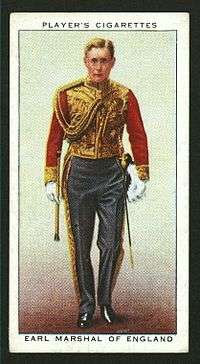 |
Bernard Marmaduke Fitzalan-Howard 16th Duke of Norfolk KG GCVO GBE TD PC (1908–1975) |
1917 | 1975 | |
Edward VIII.svg.png) (1936) | ||||
George VI.svg.png) (1936–1952) | ||||
Elizabeth II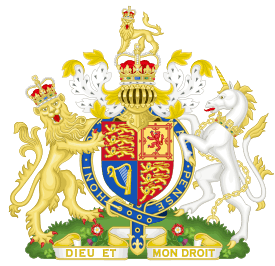 (1952–present) | ||||
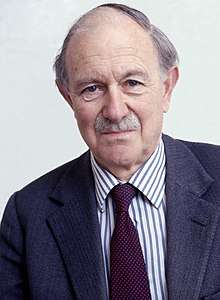 |
Miles Fitzalan-Howard 17th Duke of Norfolk KG GCVO CB CBE MC DL (1915–2002) |
1975 | 2002 | |
| Edward William Fitzalan-Howard 18th Duke of Norfolk DL (born 1956) |
2002 | Incumbent | ||
Deputy Earls Marshal
The position of Earl Marshal had a Deputy called the Knight Marshal from the reign of Henry VIII until the office was abolished in 1846.[11]
Deputy Earls Marshal have been named at various times, discharging the responsibilities of the office during the minority or infirmity of the Earl Marshal. Prior to an Act of Parliament in 1824, Protestant deputies were required when the Earl Marshal was a Roman Catholic, which occurred frequently due to the Catholicism of the Norfolks.
| Name | Tenure | Deputy to | Ref(s) |
|---|---|---|---|
| Charles Howard, 1st Earl of Carlisle | 1673–? | ||
| Charles Howard, 3rd Earl of Carlisle | 1701–1706 | ||
| Henry Howard, 6th Earl of Suffolk, 1st Earl of Bindon | 1706–1718 | ||
| Henry Bowes Howard, 4th Earl of Berkshire | 1718–1725 | ||
| Talbot Yelverton, 1st Earl of Sussex | 1725–1731 | ||
| Francis Howard, 1st Earl of Effingham | 1731–1743 | ||
| Thomas Howard, 2nd Earl of Effingham | 1743–1763 | ||
| Henry Howard, 12th Earl of Suffolk, 5th Earl of Berkshire | 1763–1765 | ||
| Richard Lumley-Saunderson, 4th Earl of Scarbrough | 1765–1777 | ||
| Thomas Howard, 3rd Earl of Effingham | 1777–1782 | ||
| Charles Howard, Earl of Surrey | 1782–1786 | ||
| Lord Henry Howard-Molyneux-Howard | 1816–1824 | 12th Duke of Norfolk | |
| Lord Edward Fitzalan-Howard | 1861–1868 | 15th Duke of Norfolk | |
| Edmund Fitzalan-Howard, 1st Viscount Fitzalan of Derwent | 1917–1929 | 16th Duke of Norfolk | |
| Edward William Fitzalan-Howard, Earl of Arundel and Surrey | 2000–2002 | 17th Duke of Norfolk |
See also
Notes
- "The history of the Royal heralds and the College of Arms". The College of Arms website. Retrieved 16 April 2009.
- Sliford 1782, p. 36
- "Archived copy". Archived from the original on 17 January 2013. Retrieved 17 January 2013.CS1 maint: archived copy as title (link)
- Companion to British History
- Squibb, G.D. (1959). The High Court of Chivalry: A Study of the Civil Law in England. Oxford, United Kingdom: Oxford University Press. pp. 79–80.
- Complete Peerage, 1st edition, Volume V, P266
- Complete Peerage, 1st edition, Volume V, P371
- Anne Mowbray Countess Marshal: Although Anne, Countess of Norfolk, Baroness Mowbray and Segrave is presumed to be the Countess Marshal, at the age of 7 on her marriage to the Duke of York, between 1476 and 1483 Sir Thomas Grey KT is said by Camden to have held the office of Earl Marshal. This hereditary claim to this office, probably descended from Sir Thomas Grey Kt (1359–1400), husband of Joan de Mowbray (1361–1410), daughter of John de Mowbray, 4th Baron Mowbray and Elizabeth de Segrave, 5th Baroness Segrave. Joan de Mowbray's son was also called Sir Thomas GREY (1384–1415) was the Sheriff of Northumberland and born at Alnwick Castle, seat of Henry Percy, 1st Earl of Northumberland. Thomas married Alice daughter of Ralph Neville, 1st Earl of Westmoreland. Another Sir John Grey KG (1386–1439) married Lady Margaret MOWBRAY (b.1388 or 1402–1459) eldest daughter of Thomas de Mowbray, 1st Duke of Norfolk (1366–1399) [Earl Marshal] and Lady Elizabeth FitzAlan (1366–1425). REF Complete Peerage. Volume V, L-M (1893) page 262
- Venning, Timothy (2005). Compendium of British Office Holders. Palgrave Macmillan. p. 480. ISBN 978-1-4039-2045-4.
- Sliford 1782, p. 37
- Money Barnes, Major R. The Soldiers of London Seeley, Service & Co 1963, p.288
References
- Chisholm, Hugh, ed. (1911). . Encyclopædia Britannica (11th ed.). Cambridge University Press.
- Sliford, William (1782). The Court Register and Statesman's Remembrancer
- Round, J.H. (1899) The Commune of London, and other Studies. Westminster: Constable.
- Debretts.com
- Tudorplace.com
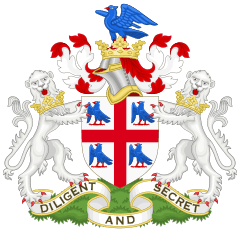
.svg.png)